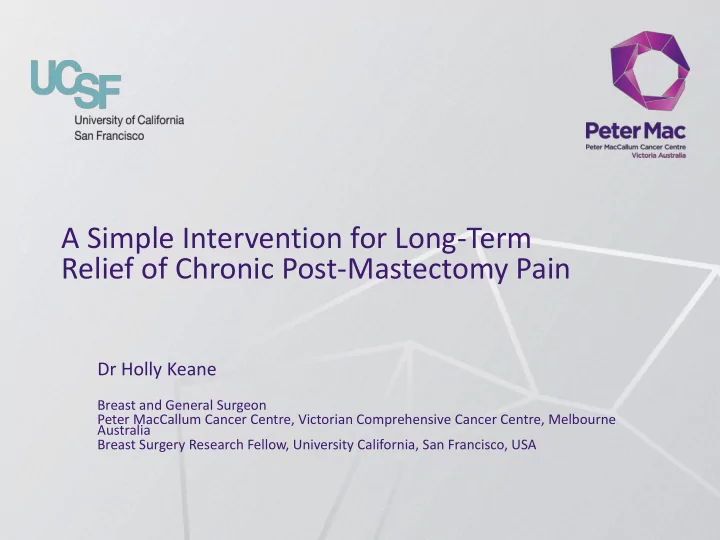

A Simple Intervention for Long-Term Relief of Chronic Post-Mastectomy Pain Dr Holly Keane Breast and General Surgeon Peter MacCallum Cancer Centre, Victorian Comprehensive Cancer Centre, Melbourne Australia Breast Surgery Research Fellow, University California, San Francisco, USA
Background - Post-mastectomy pain syndrome (PMPS) is reported to affect 25-60% of women after breast cancer surgery (Larsson, 2017) - PMPS is thought to be a type of neuropathic pain or complex chronic pain state, which is typically associated with nerve fiber injury - Despite its prevalence, PMPS is infrequently recognized (Swarm, 2013)
Background - Potential cause of PMPS - neuropathic pain condition - damage to the T4 and T5 peripheral nerves of the chest wall during surgery - resulting in hypersensitivity and neuroma formation - Clinically, this manifests as a syndrome with persistent and often debilitating pain (Rajput, 2012) - Diagnosed by identifying “trigger points” - reproducible exquisite pain upon palpation
Path of the cutaneous branches of T4 and T5 nerves as they exit the chest wall
Study Design - An observational cohort study of women with PMPS - Breast surgery practice at the University of California San Francisco Breast Care Center from August 2010 through March 2018. - Women undergoing breast surgery presenting with: - The clinical diagnosis of PMPS - Point tenderness “trigger point” on infra mammary fold
Trigger point locations
Methods: Intervention - Trigger point injections with: - 2ml of 1:1 mixture • 0.5% bupivacaine • 4 mg/mL dexamethasone - Skin marked at location trigger point - 30G needle to deposit mixture into perineural space
Methods: Assessment - Number of trigger points & injection locations - documented prospectively and verified by chart review - Patients assessed with regards to the effectiveness of the trigger point injection: - Physical examination immediately (1-3 minutes) after the injection - Long-term assessment with a telephone interview conducted at least 3 months after the intervention - Persistent or recurrent pain were offered a follow-up appointment for repeat injections
Methods: Descriptive Statistics - Electronic medical record (Apex Systems EHR), Department of Surgery, UCSF - Demographics - Type of surgery - Adjuvant radiotherapy? - Surgical complications - Duration pain - Location of trigger points - Number of injections required - Univariate and bivariate analyses were conducted using Stata 12 (College Station, TX)
Results Overall Descriptive Characteristics % Age at 1 st injection (range in years) 52 (30-92) -91 trigger points Breast operations prior to injection 2.2 (1-8 ) Duration of pain (months, range) 22.5 (0.25-144 ) Trigger points per breast (range) 1.46 (1-4) -53 women Injections performed 1.49 (1-3) Duration of pain relief (months, 34.5 (3-88) range) % surgical complications 26.2% Surgical Complication severity Minor 56.3% Major 43.8% -majority mastectomy -majority concurrent axillary surgery Overall Local treatment characteristics % Type of breast surgery lumpectomy 6.56% reduction +/-lumpectomy 26.2% mastectomy 67.2% -long term relief* 92.3% Type of axillary surgery -2 nd injection none 31.2% 25.3% sentinel node biopsy 42.6% axillary node dissection 26.2% Adjuvant Radiotherapy 34.4%
Overall Outcomes per Trigger Point Injection
Conclusions - Perineural infiltration with bupivacaine and dexamethasone is a safe, simple, and effective treatment option for PMPS with an associated trigger point. - Our data suggest this significant problem can easily be resolved in an outpatient setting. - All breast specialists should inquire about the presence of symptoms consistent with PMPS and understand the value of intervention to eliminate neuropathic pain. - This technique should be added to the armamentarium of all surgeons who perform breast surgery
References 1. The Post‐mastectomy Pain Syndrome— A Systematic Review of the Treatment Modalities - Larsson - 2017 - The Breast Journal - Wiley Online Library. https://onlinelibrary.wiley.com/doi/full/10.1111/tbj.12739. 2. Persistent Pain After Breast Cancer Treatment: A Critical Review of Risk Factors and Strategies for Prevention - ScienceDirect. https://www.sciencedirect.com/science/article/pii/S1526590010008576?via%3Dihub. 3. Survey on recognition of post-mastectomy pain syndrome by breast specialist physician and present status of treatment in Japan | SpringerLink. https://link.springer.com/article/10.1007%2Fs12282-012-0376-8. 4. Swarm RA, Abernethy AP, Anghelescu DL, et al. Adult Cancer Pain. J Natl Compr Cancer Netw JNCCN . 2013;11(8):992-1022. 5. Meijuan Y, Zhiyou P, Yuwen T, Ying F, Xinzhong C. A Retrospective Study of Postmastectomy Pain Syndrome: Incidence, Characteristics, Risk Factors, and Influence on Quality of Life. Sci World J . 2013;2013. doi:10.1155/2013/159732 6. Kehlet H, Jensen TS, Woolf CJ. Persistent postsurgical pain: risk factors and prevention. The Lancet . 2006;367(9522):1618-1625. doi:10.1016/S0140- 6736(06)68700-X 7. Rajput K, Reddy S, Shankar H. Painful Neuromas. Clin J Pain . 2012;28(7):639. doi:10.1097/AJP.0b013e31823d30a2 8. Bridges D, Thompson SWN, Rice ASC. Mechanisms of neuropathic pain. Br J Anaesth . 2001;87(1):12-26. doi:10.1093/bja/87.1.12 9. Dindo D, Demartines N, Clavien P-A. Classification of Surgical Complications. Ann Surg . 2004;240(2):205-213. doi:10.1097/01.sla.0000133083.54934.ae 10. Overview of the treatment of chronic non-cancer pain - UpToDate. 11. Jung BF, Ahrendt GM, Oaklander AL, Dworkin RH. Neuropathic pain following breast cancer surgery: proposed classification and research update. PAIN . 2003;104(1):1. doi:10.1016/S0304-3959(03)00241-0 12. Ueda H. Peripheral mechanisms of neuropathic pain – involvement of lysophosphatidic acid receptor-mediated demyelination. Mol Pain . 2008;4:11. doi:10.1186/1744-8069-4-11 13. Yoshimura M, Yonehara N. Alteration in sensitivity of ionotropic glutamate receptors and tachykinin receptors in spinal cord contribute to development and maintenance of nerve injury-evoked neuropathic pain. Neurosci Res . 2006;56(1):21-28. doi:10.1016/j.neures.2006.04.015 14. Scholz J, Woolf CJ. Can we conquer pain? Nat Neurosci . 2002;5(11s):1062-1067. doi:10.1038/nn942
Recommend
More recommend